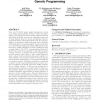Free Online Productivity Tools
i2Speak
i2Symbol
i2OCR
iTex2Img
iWeb2Print
iWeb2Shot
i2Type
iPdf2Split
iPdf2Merge
i2Bopomofo
i2Arabic
i2Style
i2Image
i2PDF
iLatex2Rtf
Sci2ools
GECCO
2008
Springer
2008
Springer
VoIP speech quality estimation in a mixed context with genetic programming
Voice over IP (VoIP) speech quality estimation is crucial to providing optimal Quality of Service (QoS). This paper seeks to provide improved speech quality estimation models with better prediction accuracy by considering a richer set of input features than the current International Telecommunications Union-Telecommunication (ITU-T) recommendations. It addresses a transitional phase, where wideband (WB) networks are becoming available. However, they have to co-exist with the existing narrowband (NB) setups for the time being. Quality estimation becomes a challenge in such a mixed context. The ITU-T recommendation (termed EModel) has recently been extended to deal with the mixed context. However, it evaluates the speech degradation in the WB scenario based solely on codec related distortions (only a subset of factors affecting the speech quality on a VoIP network). The extension is derived out of speech signals evaluated by human subjects: an expensive and difficult to reproduce exerc...
| Added | 09 Nov 2010 |
| Updated | 09 Nov 2010 |
| Type | Conference |
| Year | 2008 |
| Where | GECCO |
| Authors | Adil Raja, R. Muhammad Atif Azad, Colin Flanagan, Conor Ryan |
Comments (0)

